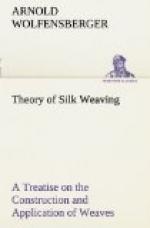Produced by Stan Goodman, Keith Edkins and the PG Online Distributed Proofreading Team
[Page
1]
theory of silk weaving
[Page
3]
theory of silk weaving
A Treatise on the Construction and Application of Weaves, and the Decomposition and Calculation of Broad and Narrow, Plain, Novelty and Jacquard Silk Fabrics
Containing 95 Plates
By Arnold Wolfensberger
Graduate of the Textile Institute of Zurich, Switzerland
* * * * *
Second Revised and Enlarged Edition
* * * * *
NEW YORK
Issued by the American silk journal
CLIFFORD & LAWTON
Publishers
1921
&nb
sp; [Page
4]
*
* * * *
Copyright. 1921. by Clifford & Lawton
All rights reserved
* * * * *
Grolier Craft Press, Printers. 229 West Twenty-eighth Street, New York City
* * * * *
[Page 5] preface
The silk industry of America has of late years rapidly advanced to the front rank among the great textile industries of the world. It may indeed be proud of this position, to which that enterprising spirit and untiring energy peculiar to our nation, combined with our great technical and natural resources, has brought it.
That we are, on the other hand, not yet at the height of perfection we are also compelled to acknowledge, but if we consider the short space of time that the American industry has required for its development, as compared to the decades, almost centuries, to which some of the great European silk centers can look back, the fact is neither surprising nor discouraging.
While it must not be our aim to imitate or copy their ways, inasmuch as out conditions and circumstances are quite different from theirs, we may still profitably study their methods in order to overcome our deficiencies.
The greatest advantage which our competitors derive from such a long existence consists in having at their disposal a force of skilful, trained help. The manufacturers, appreciating the importance of this factor, make great efforts and pecuniary sacrifices to elevate and maintain the high standard of their industry.
For instance, they support textile schools and lecture courses, where young men can acquire a thorough technical education and equip themselves for a career of usefulness, thereby serving their own interests and at the same time furthering those of their chosen profession.




